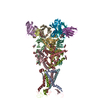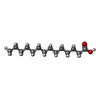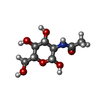[English] 日本語
 Yorodumi
Yorodumi- EMDB-48221: JUNV GP1, GP2, SSP and CR1-28 Fab complex in a pseudotyped virus ... -
+ Open data
Open data
- Basic information
Basic information
| Entry |  | ||||||||||||||||||
|---|---|---|---|---|---|---|---|---|---|---|---|---|---|---|---|---|---|---|---|
| Title | JUNV GP1, GP2, SSP and CR1-28 Fab complex in a pseudotyped virus membrane | ||||||||||||||||||
 Map data Map data | |||||||||||||||||||
 Sample Sample |
| ||||||||||||||||||
 Keywords Keywords | Viral protein / Glycoprotein / GPC / JUNV / Junin mammarenavirus / GP1 / GP2 / signal peptide / virus membrane / CR1-28 Fab / VIRAL PROTEIN-IMMUNE SYSTEM complex | ||||||||||||||||||
| Function / homology |  Function and homology information Function and homology informationhost cell Golgi membrane / receptor-mediated endocytosis of virus by host cell / host cell endoplasmic reticulum membrane / fusion of virus membrane with host endosome membrane / viral envelope / virion attachment to host cell / host cell plasma membrane / virion membrane / metal ion binding / membrane Similarity search - Function | ||||||||||||||||||
| Biological species |  Mammarenavirus juninense / Mammarenavirus juninense /  Homo sapiens (human) Homo sapiens (human) | ||||||||||||||||||
| Method | single particle reconstruction / cryo EM / Resolution: 3.8 Å | ||||||||||||||||||
 Authors Authors | Taylor LJ / Sawaya MR / Castells-Graells R / Rodriguez JA | ||||||||||||||||||
| Funding support |  United States, 5 items United States, 5 items
| ||||||||||||||||||
 Citation Citation |  Journal: Cell Rep / Year: 2025 Journal: Cell Rep / Year: 2025Title: In situ insights into antibody-mediated neutralization of a pre-fusion Junin virus glycoprotein complex. Authors: Lily J Taylor / Michael R Sawaya / Jonna B Westover / Chenyi Wang / Frederick Jimenez / Aldo J Muñoz / Julian Whitelegge / Brian B Gowen / Gustavo F Helguera / Roger Castells-Graells / Jose A Rodriguez /   Abstract: A transmembrane glycoprotein complex (GPC) decorates the Junin mammarenavirus (JUNV) that causes New World hemorrhagic fevers. We leveraged single-particle cryoelectron microscopy (cryo-EM) to image ...A transmembrane glycoprotein complex (GPC) decorates the Junin mammarenavirus (JUNV) that causes New World hemorrhagic fevers. We leveraged single-particle cryoelectron microscopy (cryo-EM) to image the full-length JUNV GPC directly on pseudotyped virus (PV) membranes and bound by two JUNV-neutralizing antibodies: Candid#1 vaccine-elicited CR1-28 and J199, a potent therapeutic against Argentine hemorrhagic fever (AHF). The 3.8 Å resolution in situ structures of the antibody-neutralized, 3-fold symmetric JUNV GPC reveal its ectodomain architecture, signal peptide-bound transmembrane region, zinc-binding luminal domain, and post-translational modifications. JUNV-GPC sequence variants highlight the functional importance of the signal peptide transmembrane helix register for virus infection and attenuating Candid#1-associated variants. Overlapping CR1-28 and J199 epitopes suggest a common receptor-blocking mechanism for JUNV neutralization, while a J199-induced, symmetric GPC reorientation may further drive its potent inhibition of JUNV lethality in mice, compared to receptor blockade alone. This underscores the utility of in situ insights into GPC function and neutralization. | ||||||||||||||||||
| History |
|
- Structure visualization
Structure visualization
| Supplemental images |
|---|
- Downloads & links
Downloads & links
-EMDB archive
| Map data |  emd_48221.map.gz emd_48221.map.gz | 117.7 MB |  EMDB map data format EMDB map data format | |
|---|---|---|---|---|
| Header (meta data) |  emd-48221-v30.xml emd-48221-v30.xml emd-48221.xml emd-48221.xml | 20.8 KB 20.8 KB | Display Display |  EMDB header EMDB header |
| Images |  emd_48221.png emd_48221.png | 96.3 KB | ||
| Filedesc metadata |  emd-48221.cif.gz emd-48221.cif.gz | 6.7 KB | ||
| Others |  emd_48221_half_map_1.map.gz emd_48221_half_map_1.map.gz emd_48221_half_map_2.map.gz emd_48221_half_map_2.map.gz | 115.8 MB 115.8 MB | ||
| Archive directory |  http://ftp.pdbj.org/pub/emdb/structures/EMD-48221 http://ftp.pdbj.org/pub/emdb/structures/EMD-48221 ftp://ftp.pdbj.org/pub/emdb/structures/EMD-48221 ftp://ftp.pdbj.org/pub/emdb/structures/EMD-48221 | HTTPS FTP |
-Validation report
| Summary document |  emd_48221_validation.pdf.gz emd_48221_validation.pdf.gz | 888.3 KB | Display |  EMDB validaton report EMDB validaton report |
|---|---|---|---|---|
| Full document |  emd_48221_full_validation.pdf.gz emd_48221_full_validation.pdf.gz | 887.8 KB | Display | |
| Data in XML |  emd_48221_validation.xml.gz emd_48221_validation.xml.gz | 14.2 KB | Display | |
| Data in CIF |  emd_48221_validation.cif.gz emd_48221_validation.cif.gz | 16.8 KB | Display | |
| Arichive directory |  https://ftp.pdbj.org/pub/emdb/validation_reports/EMD-48221 https://ftp.pdbj.org/pub/emdb/validation_reports/EMD-48221 ftp://ftp.pdbj.org/pub/emdb/validation_reports/EMD-48221 ftp://ftp.pdbj.org/pub/emdb/validation_reports/EMD-48221 | HTTPS FTP |
-Related structure data
| Related structure data |  9mewMC  9n0dC M: atomic model generated by this map C: citing same article ( |
|---|---|
| Similar structure data | Similarity search - Function & homology  F&H Search F&H Search |
- Links
Links
| EMDB pages |  EMDB (EBI/PDBe) / EMDB (EBI/PDBe) /  EMDataResource EMDataResource |
|---|
- Map
Map
| File |  Download / File: emd_48221.map.gz / Format: CCP4 / Size: 125 MB / Type: IMAGE STORED AS FLOATING POINT NUMBER (4 BYTES) Download / File: emd_48221.map.gz / Format: CCP4 / Size: 125 MB / Type: IMAGE STORED AS FLOATING POINT NUMBER (4 BYTES) | ||||||||||||||||||||||||||||||||||||
|---|---|---|---|---|---|---|---|---|---|---|---|---|---|---|---|---|---|---|---|---|---|---|---|---|---|---|---|---|---|---|---|---|---|---|---|---|---|
| Projections & slices | Image control
Images are generated by Spider. | ||||||||||||||||||||||||||||||||||||
| Voxel size | X=Y=Z: 1.114 Å | ||||||||||||||||||||||||||||||||||||
| Density |
| ||||||||||||||||||||||||||||||||||||
| Symmetry | Space group: 1 | ||||||||||||||||||||||||||||||||||||
| Details | EMDB XML:
|
-Supplemental data
-Half map: #2
| File | emd_48221_half_map_1.map | ||||||||||||
|---|---|---|---|---|---|---|---|---|---|---|---|---|---|
| Projections & Slices |
| ||||||||||||
| Density Histograms |
-Half map: #1
| File | emd_48221_half_map_2.map | ||||||||||||
|---|---|---|---|---|---|---|---|---|---|---|---|---|---|
| Projections & Slices |
| ||||||||||||
| Density Histograms |
- Sample components
Sample components
-Entire : JUNV GP1, GP2, SSP and CR1-28 Fab complex in a virus membrane
| Entire | Name: JUNV GP1, GP2, SSP and CR1-28 Fab complex in a virus membrane |
|---|---|
| Components |
|
-Supramolecule #1: JUNV GP1, GP2, SSP and CR1-28 Fab complex in a virus membrane
| Supramolecule | Name: JUNV GP1, GP2, SSP and CR1-28 Fab complex in a virus membrane type: complex / ID: 1 / Parent: 0 / Macromolecule list: #1-#5 |
|---|---|
| Source (natural) | Organism:  Mammarenavirus juninense Mammarenavirus juninense |
-Macromolecule #1: Pre-glycoprotein polyprotein GP complex
| Macromolecule | Name: Pre-glycoprotein polyprotein GP complex / type: protein_or_peptide / ID: 1 / Number of copies: 3 / Enantiomer: LEVO |
|---|---|
| Source (natural) | Organism:  Mammarenavirus juninense Mammarenavirus juninense |
| Molecular weight | Theoretical: 6.373612 KDa |
| Recombinant expression | Organism:  Homo sapiens (human) Homo sapiens (human) |
| Sequence | String: MGQFISFMQE IPTFLQEALN IALVAVSLIA IIKGVVNLYK SGLFQFFVFL ALAGRSCT UniProtKB: Pre-glycoprotein polyprotein GP complex |
-Macromolecule #2: JUNV GP1
| Macromolecule | Name: JUNV GP1 / type: protein_or_peptide / ID: 2 / Number of copies: 3 / Enantiomer: LEVO |
|---|---|
| Source (natural) | Organism:  Mammarenavirus juninense Mammarenavirus juninense |
| Molecular weight | Theoretical: 22.311578 KDa |
| Recombinant expression | Organism:  Homo sapiens (human) Homo sapiens (human) |
| Sequence | String: EEAFKIGLHT EFQTVSFSMV GLFSNNPHDL PLLCTLNKSH LYIKGGNASF KISFDDIAVL LPEYDVIIQH PADMSWCSKS DDQIWLSQW FMNAVGHDWY LDPPFLCRNR TKTEGFIFQV NTSKTGINEN YAKKFKTGMH HLYREYPDSC LDGKLCLMKA Q PTSWPLQC ...String: EEAFKIGLHT EFQTVSFSMV GLFSNNPHDL PLLCTLNKSH LYIKGGNASF KISFDDIAVL LPEYDVIIQH PADMSWCSKS DDQIWLSQW FMNAVGHDWY LDPPFLCRNR TKTEGFIFQV NTSKTGINEN YAKKFKTGMH HLYREYPDSC LDGKLCLMKA Q PTSWPLQC PLDHVNTLHF LTRGKNIQLP RRSLK UniProtKB: Pre-glycoprotein polyprotein GP complex |
-Macromolecule #3: JUNV GP2
| Macromolecule | Name: JUNV GP2 / type: protein_or_peptide / ID: 3 / Number of copies: 3 / Enantiomer: LEVO |
|---|---|
| Source (natural) | Organism:  Mammarenavirus juninense Mammarenavirus juninense |
| Molecular weight | Theoretical: 27.026191 KDa |
| Recombinant expression | Organism:  Homo sapiens (human) Homo sapiens (human) |
| Sequence | String: AFFSWSLTDS SGKDTPGGYC LEEWMLVAAK MKCFGNTAVA KCNLNHDSEF CDMLRLFDYN KNAIKTLNDE TKKQVNLMGQ TINALISDN LLMKNKIREL MSVPYCNYTK FWYVNHTLSG QHSLPRCWLI KNNSYLNISD FRNDWILESD FLISEMLSKE Y SDRQGKTP ...String: AFFSWSLTDS SGKDTPGGYC LEEWMLVAAK MKCFGNTAVA KCNLNHDSEF CDMLRLFDYN KNAIKTLNDE TKKQVNLMGQ TINALISDN LLMKNKIREL MSVPYCNYTK FWYVNHTLSG QHSLPRCWLI KNNSYLNISD FRNDWILESD FLISEMLSKE Y SDRQGKTP LTLVDICFWS TVFFTASLFL HLVGIPTHRH IRGEACPLPH RLNSLGGCRC GKYPNLKKPT VWRRGH UniProtKB: Pre-glycoprotein polyprotein GP complex |
-Macromolecule #4: CR1-28 Fab Light Chain
| Macromolecule | Name: CR1-28 Fab Light Chain / type: protein_or_peptide / ID: 4 / Number of copies: 3 / Enantiomer: LEVO |
|---|---|
| Source (natural) | Organism:  Homo sapiens (human) Homo sapiens (human) |
| Molecular weight | Theoretical: 22.62117 KDa |
| Recombinant expression | Organism:  Homo sapiens (human) Homo sapiens (human) |
| Sequence | String: IQMTQSPSTL SASVGDRVTI TCRASQSIDN WLAWYQQKPG KAPKLLIYTA SRLESGVPSR FSGSGSGTEF TLTISSLQPD DFATYYCQH RTFGQGTKVE IKRTVAAPSV FIFPPSDEQL KSGTASVVCL LNNFYPREAK VQWKVDNALQ SGNSQESVTE Q DSKDSTYS ...String: IQMTQSPSTL SASVGDRVTI TCRASQSIDN WLAWYQQKPG KAPKLLIYTA SRLESGVPSR FSGSGSGTEF TLTISSLQPD DFATYYCQH RTFGQGTKVE IKRTVAAPSV FIFPPSDEQL KSGTASVVCL LNNFYPREAK VQWKVDNALQ SGNSQESVTE Q DSKDSTYS LSSTLTLSKA DYEKHKVYAC EVTHQGLSSP VTKSFNRG |
-Macromolecule #5: CR1-28 Fab Heavy Chain
| Macromolecule | Name: CR1-28 Fab Heavy Chain / type: protein_or_peptide / ID: 5 / Number of copies: 3 / Enantiomer: LEVO |
|---|---|
| Source (natural) | Organism:  Homo sapiens (human) Homo sapiens (human) |
| Molecular weight | Theoretical: 24.168881 KDa |
| Recombinant expression | Organism:  Homo sapiens (human) Homo sapiens (human) |
| Sequence | String: QVQLVESGGG VVQPGRSLRL SCAASGFTFS SSAMHWVRQA PGKGLEWVAV IWSDGSNENY ADSVKGRFTI SRDNSKNTLY LQMSSLRAE DTAVYYCATD KTYVSGYTST WYYFNYWGQG TLVTVSGAST KGPSVFPLAP SSKSTSGGTA ALGCLVKDYF P EPVTVSWN ...String: QVQLVESGGG VVQPGRSLRL SCAASGFTFS SSAMHWVRQA PGKGLEWVAV IWSDGSNENY ADSVKGRFTI SRDNSKNTLY LQMSSLRAE DTAVYYCATD KTYVSGYTST WYYFNYWGQG TLVTVSGAST KGPSVFPLAP SSKSTSGGTA ALGCLVKDYF P EPVTVSWN SGALTSGVHT FPAVLQSSGL YSLSSVVTVP SSSLGTQTYI CNVNHKPSNT KVDKRVEP |
-Macromolecule #7: MYRISTIC ACID
| Macromolecule | Name: MYRISTIC ACID / type: ligand / ID: 7 / Number of copies: 3 / Formula: MYR |
|---|---|
| Molecular weight | Theoretical: 228.371 Da |
| Chemical component information |  ChemComp-MYR: |
-Macromolecule #8: 2-acetamido-2-deoxy-beta-D-glucopyranose
| Macromolecule | Name: 2-acetamido-2-deoxy-beta-D-glucopyranose / type: ligand / ID: 8 / Number of copies: 15 / Formula: NAG |
|---|---|
| Molecular weight | Theoretical: 221.208 Da |
| Chemical component information |  ChemComp-NAG: |
-Experimental details
-Structure determination
| Method | cryo EM |
|---|---|
 Processing Processing | single particle reconstruction |
| Aggregation state | particle |
- Sample preparation
Sample preparation
| Buffer | pH: 8 |
|---|---|
| Vitrification | Cryogen name: ETHANE / Instrument: FEI VITROBOT MARK IV |
- Electron microscopy
Electron microscopy
| Microscope | TFS KRIOS |
|---|---|
| Image recording | Film or detector model: GATAN K3 (6k x 4k) / Average electron dose: 40.0 e/Å2 |
| Electron beam | Acceleration voltage: 300 kV / Electron source:  FIELD EMISSION GUN FIELD EMISSION GUN |
| Electron optics | Illumination mode: FLOOD BEAM / Imaging mode: BRIGHT FIELD / Cs: 2.7 mm / Nominal defocus max: 2.5 µm / Nominal defocus min: 1.0 µm |
| Sample stage | Specimen holder model: FEI TITAN KRIOS AUTOGRID HOLDER |
| Experimental equipment |  Model: Titan Krios / Image courtesy: FEI Company |
+ Image processing
Image processing
-Atomic model buiding 1
| Refinement | Space: REAL |
|---|---|
| Output model |  PDB-9mew: |
 Movie
Movie Controller
Controller




 Z (Sec.)
Z (Sec.) Y (Row.)
Y (Row.) X (Col.)
X (Col.)




































